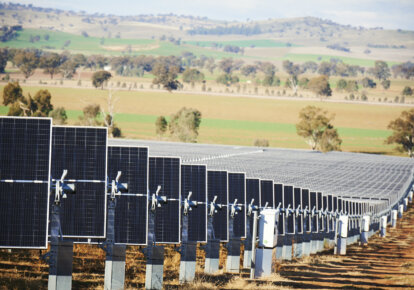On June 26 (2019), we held a webinar to share research developed in partnership with the University of Melbourne. It explores a model that can be used to map the variability of renewable pricing over the lifespan of Power Purchase Agreements (PPAs).
Deciding on an informed energy strategy can be a difficult decision for many businesses. This model gives us greater insights into energy pricing. That means, businesses can make better decisions about procuring renewables for the long-term.
Discovering the right renewable strategy for businesses
University of Melbourne Masters student, Ernesto Llamas Gomez developed a simulation tool to test the effectiveness of renewables. The model explains the impact of volume risk and demonstrates the benefits of combined wind and solar PPAs.
The simulation uses available data and applies it to a business’ current energy use to model the price variability of each PPA strategy. While it’s not a forecast, it can help predict pricing outcomes.
When modelling a 100% renewable energy strategy, expected prices across the year are typically within a 10% variance. With this tool, we can now map the price variance for a business’ energy strategy.
Putting our PPA to the test
We put this model to the test for a manufacturing business. The business was interested in locking in a 100% renewable power solution, but had questions about the long-term price outcomes and variability of renewables.
The simulation modelled the business’ energy use in three different contracting strategies – solar, wind, and a hybrid solution of both.
Overall, a blend of solar and wind optimised the coverage from renewable generation. This provided the best solution for the business to minimise price variation.
Things to take away
We’re now able to give businesses enhanced visibility into the best energy strategy to minimise price variation over the long-term.
Using a hybrid of wind and solar often delivers the least price variability, giving businesses a greater indication of market prices.
This model helps businesses make more informed decisions about their energy strategy and usage.
Q&A
Why is it that gas sets the price in the wholesale market?
Gas has the highest energy cost per megawatt hour in the energy makeup, despite not accounting for a large share of generation. Though it is only a small percentage of total generation in Australia, it often sets the price in the wholesale market as the market clearing point – where supply meets demand. Over the last few years, gas prices have tripled or quadrupled, unfortunately resulting in a higher price for electricity.
How do PPAs differ by region? i.e. for sites in VIC, NSW, SA
We have to compare against a different market price in each site. Therefore, we match a business’ load to a PPA suited to that state specifically, to eliminate any market risk. Government laws also differ across states, for instance in Queensland, renewable projects have entered the market at a slower rate and have made it more challenging. Regardless of the state, accessing a PPA through the pricing mechanics and how it offsets energy charges are the same.
With PPAs there seems to be the option to negotiate volume at production or consumption side. Which one have you negotiated?
We negotiate at the regional reference node. This means that a business is subject to volume variation, due to Marginal Loss Factors (MLF), however the price is set per megawatt hour.
There are some protections around volume risk, but we side the load to a P50 expectation of generation for that asset.
What is the ideal load for a PPA?
Our PPA model ensures that any business who meets the wholesale test can contract renewable energy. Businesses using 1 gigawatt hours a year or more are able to access this opportunity. Having access to wind and solar means that we can adjust contract levels to get a well-suited match for lots of different load profiles. Our product connects businesses directly through to specific projects, and when we get into contract negotiations with customers they get full visibility over where those projects are.
How will this PPA arrangement change if the projects expand and include batteries and will customers get the benefit of firm’ renewables to offset against pool price exposure?
We see the PPA as being complementary to batteries and offering an opportunity to benefit from the best of behind the meter and wholesale.
For specific projects that may put batteries on site, the aim is to optimise revenues at the generator level, rather than turning it into a product at the customer level.
Why have costs increased so much?
The key driver is ultimately the withdrawal of supplies. Hazelwood power station has triggered increases to price in Australia, as it was a large Victorian coal-fired power station that closed in short notice. Despite there being a lot of renewable generation developed in Australia right now, replacing supply and building new power stations will still take some time. While there is new supply coming online, there is a lead time.
What happens if the price of renewables drops dramatically during the 10 year contract? Is there any room for negotiating the price or is this the profit for the supplier for taking that price risk?
There is a risk that prices could fall, though there are also reasons why they may stabilise as well. Now is a great time to sign a PPA, due to the high wholesale prices that businesses could avoid. Wholesale prices are expected to fall in the next few years, which might mean that the savings are more modest in a few years’ time than they are right now. There is a chance that if a business waits, they could access a lower offtake agreement at a later date. But that’s offset by a missed potential opportunity because of the level of savings that can be generated by contracting renewables in today’s market where wholesale prices are really high.
What happens when there is no renewable generation?
It is important to note that a PPA is a financial product, and therefore when the sun doesn’t shine or the wind doesn’t blow, it has no effect on the supply of energy. Businesses can still use electricity as usual. During these times, a business would be exposed to the spot market prices, however the benefit of a PPA is that there are protections built into these contracts that Flow Power have previously negotiated. We pass these through to businesses and they can benefit from these protections, including a minimum generation guarantee, which can provide some comfort around the annual generation that you’ll receive.
Why did you run this model?
Simulation tools, like the one Ernesto has developed, are important in the energy industry, as it helps businesses understand uncertainty and guide better financial decision making. From this we can understand how all of those factors influence each other and drive an actual cost outcome for the customer.
Any questions? We’re here to help.
If you’re interested in learning more about renewable energy pricing, our friendly team are always available for a chat.
If you’re an existing Flow Power customer, please do not hesitate to reach out to your account manager.
If you’re not a Flow Power customer contact our friendly team today:
? 1300 08 06 08 (within business hours)
?️ Live chat message (within business hours via the chat button at the bottom of your screen)
Alternatively, you can submit your questions through our website contact form here.














